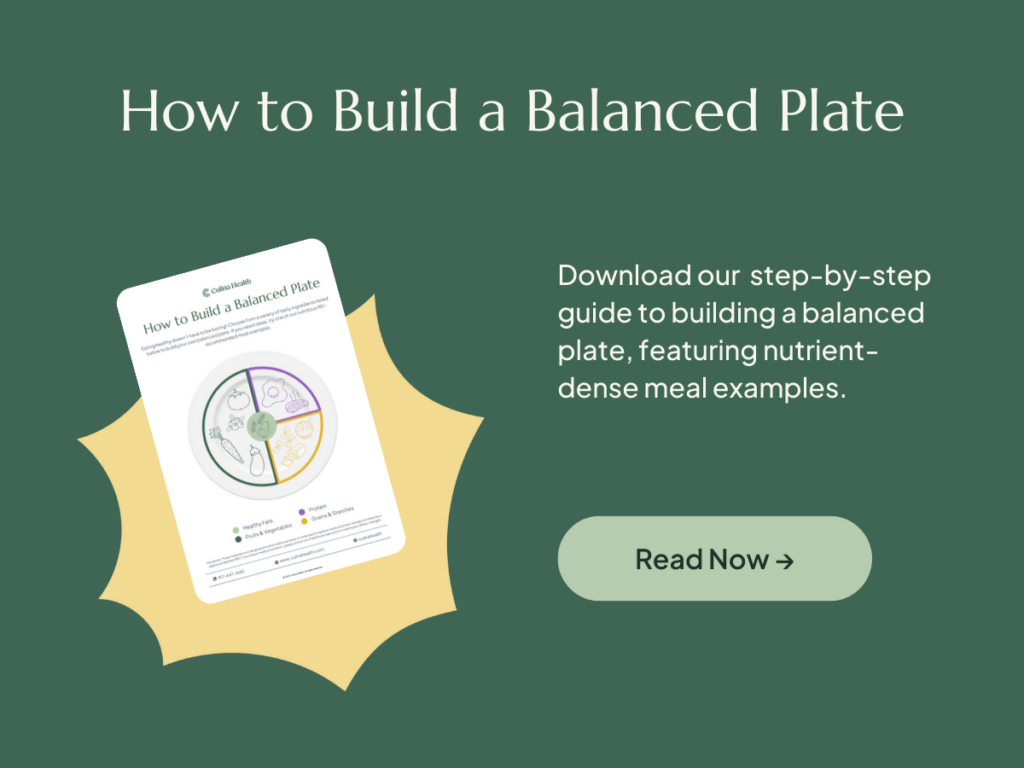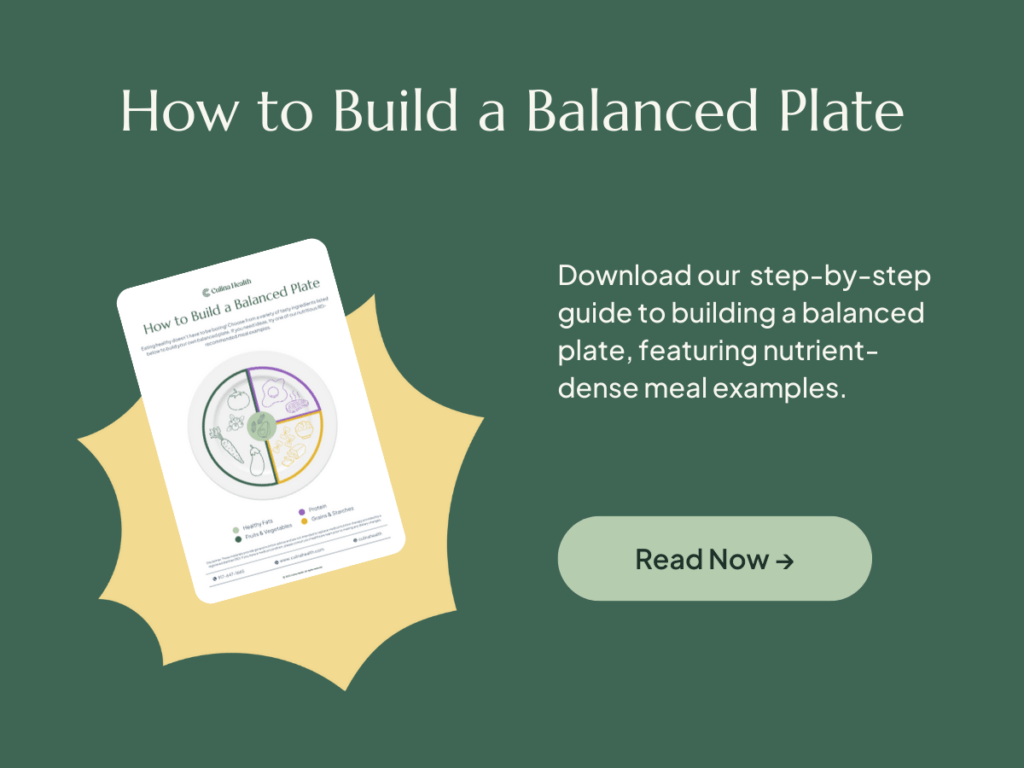The current Dietary Guidelines for Americans recommend a healthy eating pattern to promote health and prevent chronic disease, but what does that look like day-to-day?
The answer can vary depending on your individual needs, which is why working with a registered dietitian nutritionist is so helpful. If you’ve never worked with one before, we help patients make dietary and lifestyle changes to improve their overall health. As a dietitian at Culina Health, I collaborate with my patients to create health-promoting meal options that prioritize convenience and sustainability — because nobody wants a meal plan that requires a full day’s work in the kitchen or features the same five foods.
So, what’s the secret to building a healthy eating pattern? Read on to learn how registered dietitians like myself can help you build healthier, more sustainable habits.
What are Considered Healthy Habits in Nutrition?
It’s a familiar scene: in a bid to eat healthier, a well-meaning person has emptied their cabinets of candies, chips, and other temptations, and filled their grocery cart with stereotypical “diet” foods like rice cakes and cottage cheese. The problem is, they don’t like rice cakes and cottage cheese! So by the end of a few days, they are cranky, hungry, and feel defeated. Finding their kitchen empty of anything they actually want to eat, they resort to convenience foods that aren’t aligned with their health goals.
Spoiler alert: the healthiest eating habits are the ones that are enjoyable, sustainable, and good for your mental and physical health. At the heart of a nutritious diet lies a selection of thoughtfully curated foods that you truly enjoy, which balance your personal health needs and preferences. It’s not just about avoiding added sugar or saturated fat, nor is it a matter of counting calories or eating more “superfoods.”
Healthy habits look different for everyone based on various factors, including age, sex at birth, family and work demands, access to food, and health status. As a registered dietitian, I aim to help my patients incorporate foods they enjoy while ensuring they’re getting the nutrients they need to meet their health goals.
How Can Registered Dietitians Help Build Healthy Habits in Nutrition?
Registered dietitians help people build healthy habits through personalized guidance, support, and accountability. We are clinically trained to provide medical nutrition therapy and practical strategies to implement nutrition and lifestyle changes. Our goal is to help patients make small, sustainable shifts in their day-to-day lives that lead to lasting results over time.
Regular nutrition coaching sessions with a registered dietitian will teach you to make life-sustaining food choices. Whether you’re trying to eat more greens or reduce your salt intake, your dietitian’s encouragement will help you build new habits that can evolve as your health needs change.
5 Steps to Building a Healthy Plate
With a little planning, you can build a healthy plate with balanced portions that meet your specific nutrient goals. At Culina Health, we work with patients to personalize the macronutrient composition of their meals while also incorporating their favorite cultural foods.
However, the following general guidelines can help you get started:
1. Fill 1/4 of your plate with protein
Whether you enjoy meat and poultry or follow a plant-based diet, you likely plan many of your meals around the protein. A delicious piece of fish, steak, or tofu may be the star, but protein should still only take up about 1/4 of your overall plate. However, optimal amount of protein for you depends on your activity level, age, health status, birth-assigned sex, and metabolism.
2. Fill 1/4 of your plate with starch
There are so many options for fiber-rich starches. Choose from grains like quinoa, farro, rice, oats, or whole grain pasta or bread. You can also cook up starchy vegetables like potatoes, yams, corn, squash, yucca, or plantains. Just keep your portions in mind: like protein, starch should only fill about 1/4 of your plate.
3. Fill the remaining 1/2 of your plate with non-starchy vegetables
Aim to fill half of your plate with non-starchy vegetables every time. In addition to providing essential vitamins, minerals, and phytonutrients, fiber-rich veggies offer so many other health benefits including reducing cholesterol and blood pressure. They can also help decrease your risk of developing cardiovascular disease and certain cancers.
4. Add a serving of healthy fat
Don’t forget the fat! Fat is essential, despite what 1980s diet trends might tell you. Healthy fats support cell structure and integrity, vitamin absorption, hormone production, and brain function, while also providing long-lasting energy. Incorporate fats while you’re cooking, or add a ½ tablespoon (1-2 thumb-sized portions) of flavorful fat to your finished plate (think avocado, feta cheese, or salad dressing).
4. Eat mindfully
We have all experienced mindless eating while commuting to work, sitting at our desk, or standing at the kitchen counter wrangling kids. However, It’s important to prioritize mindful eating. Eating slowly, limiting distractions, and tuning into your body’s hunger and fullness cues can help you enjoy your food more and know when you’ve eaten enough.
Benefits of Building a Healthy Plate at Mealtime
Building a healthy plate is about more than following a trend or reaching a goal weight; it’s about nurturing your body and mind with every bite. The benefits of well-balanced meals extend far beyond simply satisfying your hunger. You can enjoy a positive relationship with food knowing that fueling yourself is a form of self-care. And unless you have a specific food allergy or intolerance, all foods can fit; you just have to be conscious of the quality and quantity of what you’re putting on your plate.
7 Healthy Eating Habits From a Registered Dietitian
Healthy eating looks different for everyone, but integrating these simple habits into your routine are important no matter your health goals:
1. Eat the rainbow
Colorful fruits and vegetables contain many nutrients, and a variety of colors equates to a variety of textures, flavors, nutrients, and health benefits.
2. Combine 3+ food groups for meals and snacks
Think protein, healthy fats, and fiber. This will add to the satiety factor, giving you long-lasting energy and allowing you to focus on the non-food-related parts of your day.
3. Add vegetables and fruits whenever possible
You don’t have to replace your go-to lunch order with a sad salad — in fact, please don’t! Simply add fresh or cooked veggies or fruits to your favorite meals to boost their nutritional value.
4. Shop strategically at the grocery store
Shopping for whole foods instead of packaged foods can help you save money at the grocery store. Avoid processed food and go for fresh in-season produce when possible. And don’t forget the freezer aisle for cheaper fruit and veggie options.
5. Eat meals at regular intervals
It’s hard to feel your best when you aren’t nourished. Even if weight loss or weight management is your goal, skipping meals can lead to binging. Eat balanced meals at regular intervals to avoid blood glucose dips that leave you feeling foggy, irritable, and exhausted.
6. Indulge in treats — in moderation
If you’re craving something sweet or rich — congratulations, that makes you human! Sustainable healthy eating plans make room for beloved foods on occasion. It’s all about balance.
7. Drink plenty of water
The general guidelines for water intake are 9 cups per day for people assigned female at birth and 13 cups for people assigned male at birth. However, these amounts can vary based on your age, activity level, and overall health. If getting enough water seems difficult to achieve, try some water-based beverages like tea or coconut water, and eat hydrating foods like cucumber, melon, strawberries, and cabbage.
Build Healthy Habits in Nutrition With Culina Health
The foods you choose have a huge impact on your health and wellness. With a registered dietitian on your team, you can learn to make choices that make the most sense for your needs.
Whether you’re looking to manage a medical condition or simply want to learn to build healthy habits in nutrition and heal your relationship with food, a registered dietitian can help. Meet virtually with a Culina Health registered dietitian to discover a nutrition plan that works for your lifestyle. Every bite is a step towards a healthier, happier you — and we can raise our forks to that! Get started with Culina Health today.








